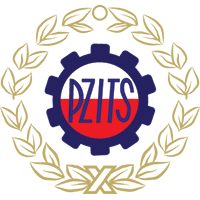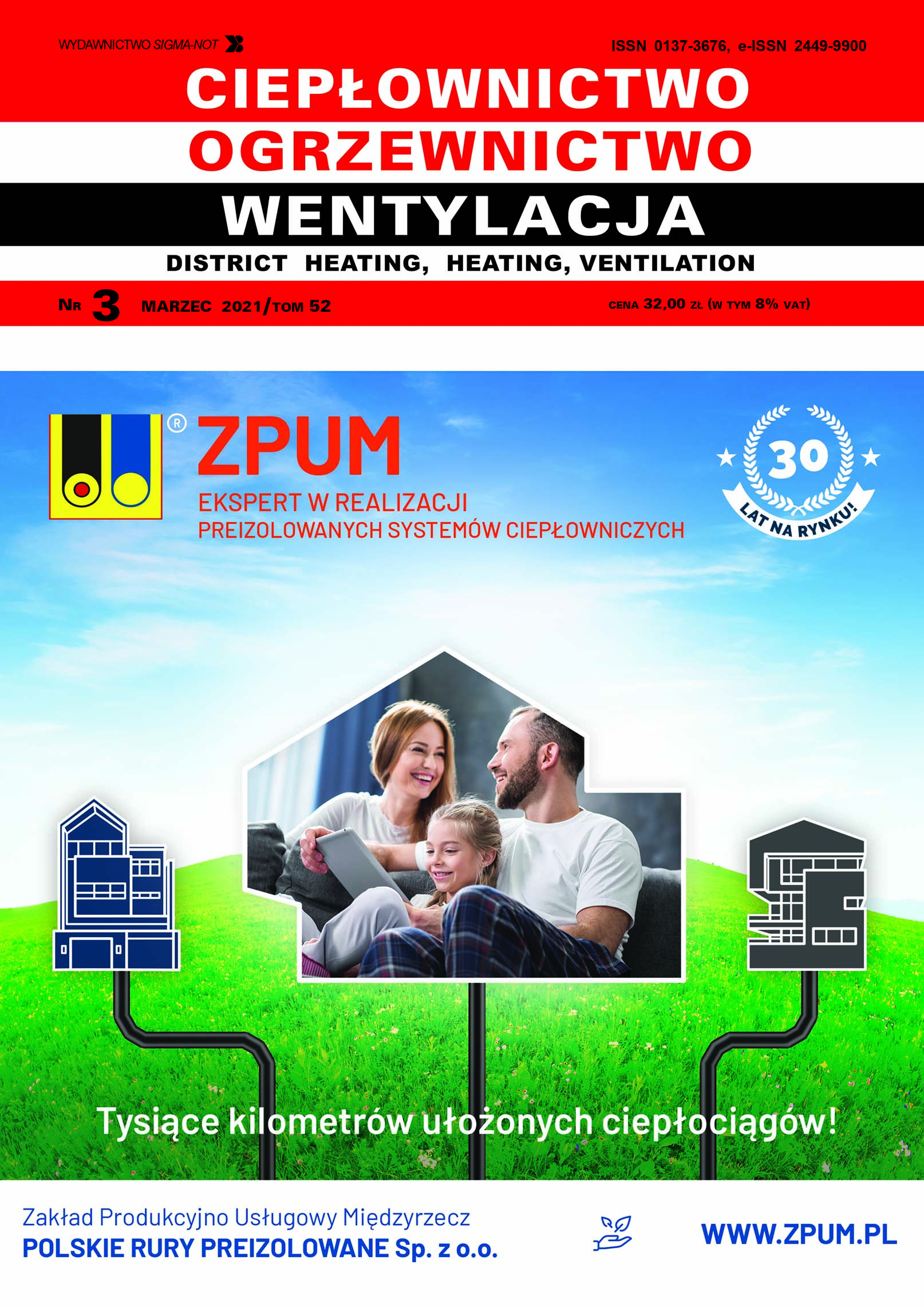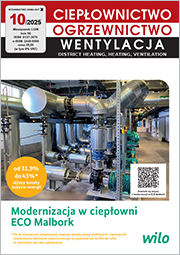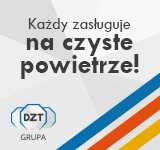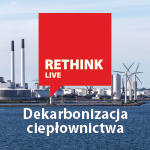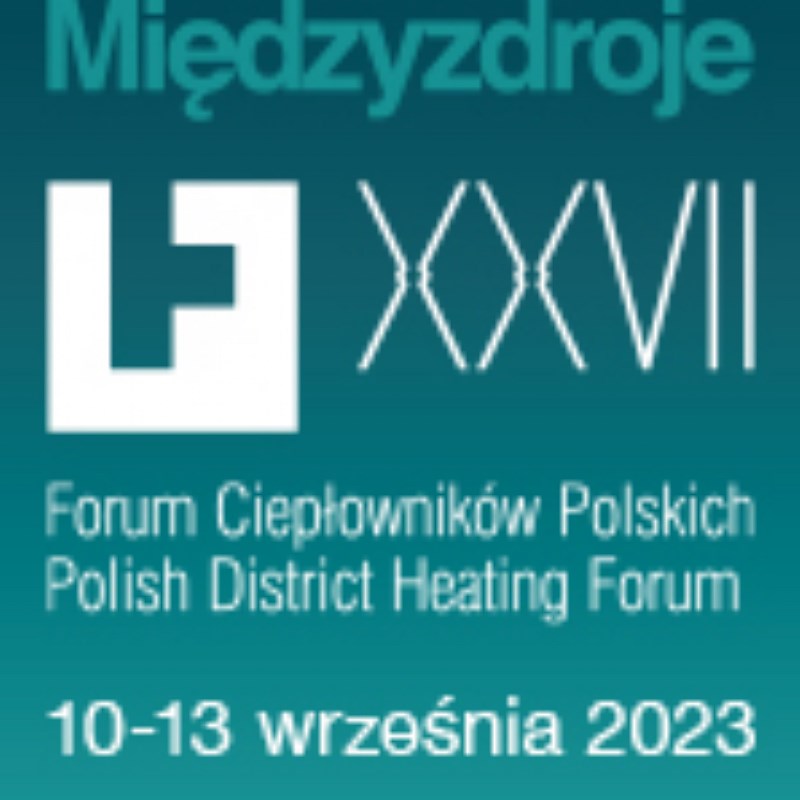CIEPŁOWNICTWO – DISTRICT HEATING • OGRZEWNICTWO – HEATING
Opłacalność zastosowania pompy ciepła w układach centralnego ogrzewania i ciepłej wody użytkowej. (DOI: 10.15199/9.2021.3.1)
Profitability of Using a Heat Pump in Central Heating and Domestic Hot Water Systems ‒ Karol Olszewski, Blanka Jakubowska ……………………………….2
Słowa kluczowe: pompa ciepła, ciepła woda użytkowa, centralne ogrzewanie
Streszczenie
W artykule przedstawiono problem opłacalności ekonomicznej stosowania pompy ciepła, w układach ciepłej wody użytkowej oraz centralnego ogrzewania. Zasadność zastoso-wania takich źródeł ciepła w tych instalacjach spowodowana jest ogólnoświatowymi kie-runkami i stopniowym odchodzeniem od konwencjonalnych źródeł energii takich jak kotły olejowe lub gazowe.
Przedmiotem artykułu był budynek jednorodzinny o powierzchni użytkowej ok. 145 m2, w którym instalacja c.o. oraz c.w.u. byłaby zasilana gruntową pompą ciepła. Do analizy przyjęto dwa warianty instalacji c.o., tj. dwururową grzejnikową z rozdziałem dolnym oraz ogrzewanie podłogowe. W przypadku instalacji ciepłej wody użytkowej przyjęto jeden wariant układu centralnego przygotowaniu c.w.u. i magazynowanej w zbiorniku znajdującym się wewnątrz obudowy pompy ciepła. Do analizy opłacalności użyto metodę prostego czasu zwrotu nakładów inwestycyjnych, w której pompa ciepła została po-równana z konwencjonalnym źródłem ciepła.
Keywords: heat pump, domestic hot water, central heating
Abstract
In this paper has been presented the problem of economic profitability in the case of using an ecological heat source, which is a heat pump, in domestic hot water and central heating systems. The validity of using of renewable heat source in these installations is due to global trends and departure from conventional energy sources such as boilers using hard coal, heating oils or natural gas as fuel. In order to carry out the analysis, a single-family building has been used with a usable area of 145 m2, in which the central heating installation and domestic hot water would be powered by a ground source heat pump. Two variants of the central heating installation were adopted for the analysis, i.e. a two-pipe system with bottom distribution of radiators and underfloor heating. In the case of domestic hot water installations, one variant of was adopted with the central preparation of domestic hot water and storage in a tank located inside the heat pump housing. For the profitability analysis, the simple investment payback time method has been used, where the heat pump has been compared with a conventional source of heat energy.
Przegląd energooszczędnych rozwiązań instalacji ogrzewania, wentylacji i ciepłej wody w budownictwie. (DOI: 10.15199/9.2021.3.2)
Overview of Energy-Efficient Solutions for Heating, Ventilation and Hot Water in Buildings‒Władysław Szaflik………9
Słowa kluczowe: instalacje energooszczędne, centralne ogrzewanie, wentylacja, instala-cje ciepłej wody, zużycie energii w budownictwie
Streszczenie
W artykule przedstawiono rozwiązania instalacji ogrzewania, wentylacji i ciepłej wody w budynkach pozwalające na zmniejszenie zużycia energii w porównaniu z rozwiązaniami klasycznymi. Omówiono sposoby obniżenia zużycia energii dzięki odpowiedniemu wyko-naniu instalacji ogrzewania, wentylacji i ciepłej wody oraz ich wyposażeniu i eksploatacji.
Keywords: energy-saving installations, central heating, ventilation, hot water installa-tions, energy consumption in construction
Abstract
The article presents solutions for central heating, ventilation and hot water installations in buildings which enable reduction of consumption of purchased energy compared to traditional solutions. Ways of reducing energy consumption by appropriate heating, ventilation and hot water installations as well as their equipment and operation were discussed.
Zastosowanie BIM w projektowaniu instalacji ogrzewczych w oprogramowaniu z serii Audytor. (DOI: 10.15199/9.2021.3.3)
Application of BIM in the Design of Heating System in the Audytor Series Software ‒ Michał Strzeszewski, Piotr Wereszczyński……………………15
Słowa kluczowe: ogrzewanie, chłodzenie, hydraulika, BIM, Audytor, Revit
Streszczenie
W artykule omówiono wykorzystanie technologii BIM w projektowaniu instalacji ogrzew-czych w oprogramowaniu z serii Audytor we współpracy z programem Autodesk® Revit®. Przedstawiono również najnowsze możliwości programu Audytor OZC i Audytor SET oraz prowadzone prace rozwojowe.
Keywords: BIM, energy auditing, heating, cooling, plumbing
Abstract
The article discusses the application of BIM technology in the design of heating systems in the Audytor software in cooperation with the Autodesk® Revit® program. The latest capabilities of the Audytor HL and Audytor SET programs, as well as ongoing develop-ment work, were also presented.
WENTYLACJA ● KLIMATYZACJA – VENTILATION ● AIR-CONDITIONING
Przegląd wymagań normatywnych dotyczących komfortu cieplnego chirurgów i personelu medycznego w salach operacyjnych. (DOI: 10.15199/9.2021.3.4)
Review of Standards and Requirements Related to the Thermal Comfort of Surgeons and Medical Staff in the Operating Rooms‒ Dominika Ćwiklińska, Anna Bogdan…………………………………………………………..22
Słowa kluczowe: komfort cieplny, odczucia cieplne, chirurdzy, personel medyczny, sale operacyjne
Streszczenie
Projektowanie warunków środowiska wewnętrznego w salach operacyjnych jest trudnym wyzwaniem, w którym przede wszystkim należy uwzględnić wysokie wymagania odnośnie do jakości powietrza i zabezpieczenia pacjenta. Od kilku lat coraz więcej badań naukowych prowadzonych jest również w zakresie zapewnienia chirurgom i personelowi medycznemu odczuć komfortu cieplnego przy zachowaniu warunków zapobiegających wystąpieniu niezamierzonej hipotermii okołooperacyjnej pacjentów. Jako wkład w prowadzoną dyskusję w ramach niniejszego artykułu sprawdzono, jak warunki środo-wiska cieplnego są definiowane w poszczególnych dokumentach normatywnych i wy-tycznych, z których korzystają projektanci systemów wentylacji i klimatyzacji.
Keywords: thermal comfort, thermal sensation, surgeons, metical personnel, operating theatre
Abstract
Designing the conditions of the indoor environment in operating theatres is a difficult challenge, in which, above all, high requirements regarding air quality and patient pro-tection should be taken into account. For several years, more and more scientific re-search has also been conducted in the field of providing surgeons and members of medical team sensation of thermal comfort while also maintaining conditions preventing the occurrence of patients’ unintentional perioperative hypothermia. As a contribution to the discussion, this paper summaries how the thermal environment conditions are de-fined in individual normative documents and guidelines used by designers of ventilation and air conditioning systems.
Wybrane aspekty projektowania maszynowni chłodniczych i pomp ciepła z czynnikiem R-744. (DOI: 10.15199/9.2021.3.6)
Selected Aspects of Designing Engine Rooms for Refrigeration and Heat Pumps with R-744 Refrigerant‒ Marian Rubik, Piotr Ziętek………………………………27
Słowa kluczowe: dwutlenek węgla, palność, toksyczność, klasa bezpieczeństwa, prak-tyczna granica stężenia, toksyczność ostra, granica ubytku tlenu
Streszczenie:
W artykule omówiono właściwości dwutlenku węgla w aspekcie projektowania maszy-nowni chłodniczych z urządzeniami napełnionymi tym czynnikiem. Podano również in-formacje dotyczącego wpływu R-744 na organizm człowieka
Keywords: carbon dioxide, flammability, toxicity, safety class, practical concentration limit, acute toxicity, oxygen depletion limit
Abstract:
The paper discusses the properties of carbon dioxide in the aspect of design of refrige-rating machine rooms with equipment filled with this agent. Information ha salso been provided on the effects of R-744 ob. The human body

